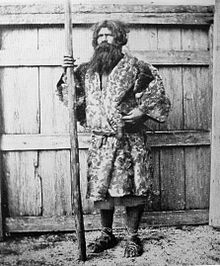Tabaccus Maximus
Tabaccus Maximus
- Messages
- 169
- Reaction score
- 22
- Points
- 0
- Ethnic group
- Galo-Germanic Atlantic Fringe
- Y-DNA haplogroup
- R1b - SRY 2627
- mtDNA haplogroup
- H1a
GR&A: Please, no comments about ginger warriors!! Serious responses only.
Let me pose the question outright:
Does anyone know of a large study on Japanese Y haplotypes and the percentage of R1a in Japan?
I was reading and looking at some maps in Genebase and noticed trace amounts of R1a throughout Japan, specifically concentrated in Kofun strongholds such as the Yamato area.
Here's the background:
The incipient phase of the Jomon period ceramic pottery begins about 10k b.c. and continues until the Yayoi period, being introduced from China or the Korean penninsula. I spent some time recently at the Japanese national museum and the Jomon pottery is incredibly fine, even during the incipient phase. The Yayoi brought bronze and wet rice farming and this may have involved waves extending for several hundred years from the mainland. The Kofun statuettes were a little surprising though, in that many of them appear clearly 'not local'.
So..
The Kofun period brings a radical change to Japanese culture. The Kofun period warriors are typically buried in 'Kurgan style' burials. Above the graves are terracotta men with curly hair, deep eys, pointed beards, witch hats, tunics and daggers attached at the hips. They are a horse culture and introduce iron during this period. This period brought a clan based warrior warrior chiefs and marshall law. As the period progresses, you being to see the introduction of Buddahism by way of the Yamato clan.
Now first, there are trace amounts of R1b apparently in Japan. I would entirely expect this to be from 500 years of gene flow through trade. Certainly some missionaries and traders settled and married here.
R1a, on the other hand, seems more difficult to place in a historical context. I would expect some trace R1a to enter Japan via Buddahist evangelization, with inputs coming from India, Southeast Asia or the Steppes from where it mostly spread throughout Asia.
I'm curious if the Kofun culture originated from one of the historical steppe cultures such as the WuHu (Xiongnu, Di, Qiang, etc) in North Eastern Siberia. Many artifacts in Korea and Japan, such as traditional headgear, appear to have some connection with the Siberian Steppes..
Long story short, I haven't been able to find anything useful on dna analysis or mapping of Japan. Most seem to treat Japan as an open and closed book. Looking for more informaion....
Let me pose the question outright:
Does anyone know of a large study on Japanese Y haplotypes and the percentage of R1a in Japan?
I was reading and looking at some maps in Genebase and noticed trace amounts of R1a throughout Japan, specifically concentrated in Kofun strongholds such as the Yamato area.
Here's the background:
The incipient phase of the Jomon period ceramic pottery begins about 10k b.c. and continues until the Yayoi period, being introduced from China or the Korean penninsula. I spent some time recently at the Japanese national museum and the Jomon pottery is incredibly fine, even during the incipient phase. The Yayoi brought bronze and wet rice farming and this may have involved waves extending for several hundred years from the mainland. The Kofun statuettes were a little surprising though, in that many of them appear clearly 'not local'.
So..
The Kofun period brings a radical change to Japanese culture. The Kofun period warriors are typically buried in 'Kurgan style' burials. Above the graves are terracotta men with curly hair, deep eys, pointed beards, witch hats, tunics and daggers attached at the hips. They are a horse culture and introduce iron during this period. This period brought a clan based warrior warrior chiefs and marshall law. As the period progresses, you being to see the introduction of Buddahism by way of the Yamato clan.
Now first, there are trace amounts of R1b apparently in Japan. I would entirely expect this to be from 500 years of gene flow through trade. Certainly some missionaries and traders settled and married here.
R1a, on the other hand, seems more difficult to place in a historical context. I would expect some trace R1a to enter Japan via Buddahist evangelization, with inputs coming from India, Southeast Asia or the Steppes from where it mostly spread throughout Asia.
I'm curious if the Kofun culture originated from one of the historical steppe cultures such as the WuHu (Xiongnu, Di, Qiang, etc) in North Eastern Siberia. Many artifacts in Korea and Japan, such as traditional headgear, appear to have some connection with the Siberian Steppes..
Long story short, I haven't been able to find anything useful on dna analysis or mapping of Japan. Most seem to treat Japan as an open and closed book. Looking for more informaion....


